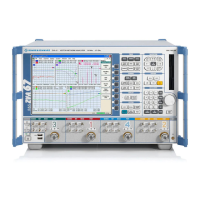System Overview
R&S
®
ZVA
67Getting Started 1145.1090.62 ─ 13
3.2.4 Display Formats and Diagram Types
A display format defines how the set of (complex) measurement points is converted
and displayed in a diagram. The display formats in the "Trace – Format" menu use the
following basic diagram types:
●
Cartesian (rectangular) diagrams are used for all display formats involving a con-
version of the measurement data into a real (scalar) quantity, i.e. for "dB Mag",
"Phase", "Delay", "SWR", "Lin Mag", "Real", "Imag" and "Unwrapped Phase".
●
Polar diagrams are used for the display format "Polar" and show a complex quan-
tity as a vector in a single trace.
●
Smith charts are used for the display format "Smith". They show a complex quan-
tity like polar diagrams but with grid lines of constant real and imaginary part of the
impedance.
●
Inverted Smith charts are used for the display format "Inverted Smith". They show
a complex quantity like polar diagrams but with grid lines of constant real and
imaginary part of the admittance.
The analyzer allows arbitrary combinations of display formats and measured quantities
("Trace – Measure"). Nevertheless, in order to extract useful information from the data,
it is important to select a display format which is appropriate to the analysis of a partic-
ular measured quantity; see chapter 3.2.4.6, "Measured Quantities and Display For-
mats", on page 75.
3.2.4.1 Cartesian Diagrams
Cartesian diagrams are rectangular diagrams used to display a scalar quantity as a
function of the stimulus variable (frequency / power / time).
●
The stimulus variable appears on the horizontal axis (x-axis), scaled linearly
(sweep types "Lin Frequency", "Power", "Time", "CW Mode") or logarithmically
(sweep type "Log Frequency").
●
The measured data (response values) appears on the vertical axis (y-axis). The
scale of the y-axis is linear with equidistant grid lines although the y-axis values
may be obtained from the measured data by non-linear conversions.
The following examples show the same trace in Cartesian diagrams with linear and
logarithmic x-axis scaling.
Screen Elements

